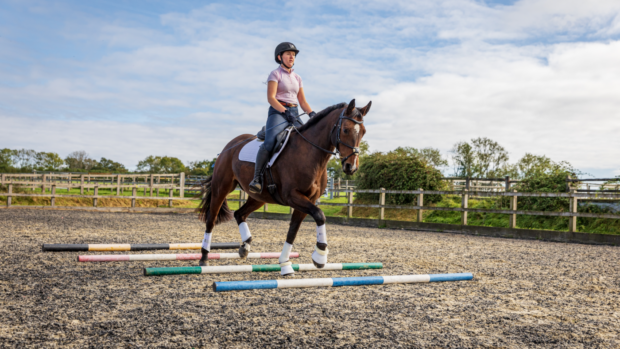We’ve scooped up some expert tips and advice from some top trainers for developing both horse and rider using trotting pole exercises.
Trotting poles: exercise one
Place three poles on the ground 4’6” apart and trot over them while standing up in your stirrups. Develop the exercise by raising one end of each pole before progressing to having both ends of each pole raised.
Aim: To improve a rider’s balance and core strength and to improve the horse’s suppleness while working on his coordination.
Richard Waygood, World Class programme eventing performance manager, says: “Ensure the weight is through your heels, your head is up and you are looking straight ahead. Engage your core and don’t tip forward or hold onto your horse through the reins — by all means use the neckstrap to balance. Don’t forget to start and finish the exercise in the correct way of going, don’t collapse in the saddle after the final pole and then fall in around the corner, make sure you stay straight.”
 Watch the video
Watch the videoTrotting poles: exercise two
Arrange six poles on the ground in a zigzag formation then trot over the middle of the poles.
Aim: To teach horse and rider to stay straight down the middle of the poles regardless of their angle. This exercise also increases the horse’s desire to be careful and thoughtful.
Ros Canter, eventing world, European and team Olympic gold medallist, says: “Using poles in a zigzag really helps the rider to pick up on any problems the horse and rider are having with straightness as the horse may try and follow the angle of the poles instead of staying to the middle of the exercise. The rider should concentrate on finding something to look at above and beyond the poles instead of looking at the poles themselves. This will help to educate the rider in keeping their horse straight through their feel and body aids, not just their eyes and hands.”
Trotting poles: exercise three
Place three sets of five poles in a line on the ground with a strided space distance between them. Each set should be spaced differently so your horse has to adjust his stride length from short to regular to long or vice versa. This exercise is normally ridden in trot but could also be done in canter if the poles are are appropriate distance apart.
Aim: To improve the riding of transitions between the different types of trot or canter as well as to help to shorten or increase the horse’s stride length. All of which will improve the horse’s co-ordination, balance and confidence. This exercise also improves the rider’s skillsets as well as their understanding and feel for the different types of trot or canter.
Sam York, FBHS UKCC Level 3 and British Eventing accredited coach, says: “You will need to trot much slower than you think to maintain balance and to ensure the horse does not hit the poles. Keep your eyes straight ahead, your hands soft and use the half halt when necessary. If your horse is coming into the poles in a strong manner, bring him in on a smaller turn or circle so he can’t rush. When doing this exercise in trot, ensure you keep rising through the poles and try to slow your rise a fraction so your body language helps to rebalance the horse and slows him down. This ensures the horse has to think more about what he is doing. This all helps to improve and develop the different paces within paces and increase cadence as well as rhythm and balance.”
- To stay up to date with all the breaking news throughout the Paralympics, Burghley, HOYS and more, subscribe to the Horse & Hound website
You might also be interested in:
Fancy footwork: how to get the most from your horse’s jumping canter
Caroline Moore, former five-star eventer and British Eventing national under-18 coach and junior team coach, explains how you can use

Subscribe to Horse & Hound magazine today – and enjoy unlimited website access all year round





